Washington Watch
-
- WASHINGTON WATCH: A Tale of Two Fleets Marine News, Apr 2019 #24
Mixed Government Support for U.S. Shipbuilding.
It has been a busy start to the 116th Congress for the U.S. shipbuilding industry, with three congressional hearings in early March focused on the industry’s role as a critical component of the U.S. national security industrial base. In addition, the Consolidated Appropriations Act, 2019, which was signed into law on February 15, contained mixed news for shipbuilding programs. Through the congressional hearings and enacted legislation, two opposing themes have emerged. First, on the positive side, there is strong support for domestic shipbuilding projects to recapitalize U.S. government-owned fleets. Second, on the negative side, support for commercial projects in U.S. shipyards remains intermittent and falls well short of the support shown by foreign governments for their domestic shipbuilding industries.
U.S. Government Sealift Fleet
Hearings before (1) the House Subcommittee on Coast Guard and Maritime Transportation, (2) a joint session of the House Subcommittee on Seapower and Projection Forces and Subcommittee on Readiness, and (3) the Senate Committee on Commerce, Science, and Transportation, provided opportunities for leadership from the Maritime Administration (MARAD), United States Transportation Command (USTRANSCOM), U.S. Coast Guard (USCG), together with members of the maritime industry, to educate Congress on the strategic and economic importance of America’s shipyards.A constant theme through all three hearings was the critical need to recapitalize the federal government’s organic sealift fleet, comprised of MARAD’s 46 ship Ready Reserve Force (RRF) and the Military Sealift Command’s 15 ship Surge Sealift Fleet. Disturbingly, as emphasized by USTRANSCOM Commander General Stephen Lyons, 19 of the 61 vessels in the combined fleet (31%) are either “not mission capable” or have lost their USCG Certificate of Inspection. Combined with the demonstrated U.S. mariner shortage, and a continually shrinking U.S.-flag international commercial fleet, the United States is woefully unprepared to meet its military’s sealift requirements.
Maritime Administrator Mark Buzby testified that MARAD has adopted a three-prong approach to recapitalize the U.S. government sealift fleet, which includes the purchase of used vessels from the open market for rebuild in U.S. shipyards, and building new vessels domestically. Continuing his trend as a champion for the U.S. shipbuilding industry, Rep. John Garamendi (D-CA) emphasized the need at both House hearings for U.S. shipyards to have a full role in repurposing any used vessels purchased by MARAD.
MARAD has taken the first step to implement its plan, issuing a Request for Information (RFI) on February 14 to identify existing RO/RO vessels that could replace its aging RRF capacity. According to the RFI, the vessels must be available for acquisition between July 1, 2019 and December 31, 2022. If MARAD follows through on these plans, American shipyards potentially can expect an influx of rebuild work from the federal government in the coming years. Unfortunately, Administrator Buzby also testified that MARAD is likely five or more years away from pursuing any new build projects to recapitalize the RRF.
However, while new-build RRF ships are unlikely, there are other areas where new build projects will be moving forward. For example, the Consolidated Appropriations Act, 2019, contained $300 million in funding for the construction of a second National Security Multi-Mission Vessel (NSMV), to replace Massachusetts Maritime Academy’s T/S KENNEDY. During the recent hearings, Rep. Randy Weber (R-TX) also voiced his strong support for Fiscal Year 2020 funding for a third NSMV to replace Texas A&M Maritime Academy’s T/S GENERAL RUDDER. The Act also included $655 million for production of the first USCG Polar Security Cutter (PSC) and an additional $20 million for long lead time materials for a second PSC. Congress also appropriated $100 million for additional USCG Fast Response Cutters.
In addition to these prospective and funded projects, during the Senate Commerce Committee hearing, Senator Tammy Baldwin (D-WI) voiced her intent to reintroduce the Made in America Shipbuilding Act, which would require all federal government contracts for the construction or conversion of a vessel to be performed in U.S. shipyards. The bill also requires certain enumerated vessel components included in such projects to be constructed domestically. Collectively, it appears that the U.S. government may be an increasing part of U.S. shipyards’ customer base in the coming years.
Support for Commercial Shipbuilding
While the news out of Washington is relatively positive for government projects, support for commercial projects is less encouraging. For example, the Governor of Puerto Rico has requested a 10-year waiver of the Jones Act, arguing the waiver’s necessity to support the transportation of liquefied natural gas to Puerto Rico. Troublingly, the Executive Branch has not yet denied the waiver. Members of the maritime industry testified that a waiver of the Jones Act would (among other impacts) undermine the domestic shipbuilding industry and negatively impact our national security. More to the point, members of Congress and the shipbuilding industry strenuously maintained that there is no national defense basis for the waiver, as required by federal law.Following the theme of questionable support, the Consolidated Appropriations Act again failed to provide funding for MARAD’s Federal Ship Financing Program (Title XI). The program currently has $32 million in available subsidy, equating to approximately $504 million in loan guarantees. However, with the recent approval of Title XI financing for Matson’s two containerships currently nearing completion at Philly Shipyard, the program is virtually out of money. Accordingly, vessel owners will have to continue relying on the commercial market to finance new vessel construction projects.
The news is not all negative, however, with the Consolidated Appropriations Act providing $20 million in funding for the Small Shipyard Grants program. MARAD issued a Notice of Funding Availability on March 8th, with applications due by April 15th. In addition, MARAD’s two tax deferral programs – the Capital Construction Fund (CCF) and Construction Reserve Fund (CRF) – remain intact despite recent changes to the Internal Revenue Code. When enrolled in these programs, U.S. vessel operators can continue to defer tax on operating income and/or vessel sale proceeds, depending on the vessel operator’s trade, to support shipbuilding projects.
Thus, what ultimately emerges is a mixed tale of support for the U.S. shipbuilding industry. While the government is taking positive steps to invest in the recapitalization of its own fleets, it is also providing, at best, tacit support for commercial shipbuilding projects. In stark contrast, as Congress heard during recent testimony, countries such as China and Korea are providing billions in subsidies to their domestic shipyards as critical component of their overall national security strategy. Without similar investment, recent Congressional statements about the strategic national importance of our domestic shipbuilding industry are meaningless.
Jeff Vogel is a Member in Cozen O’Connor’s Transportation & Trade Group. He can be reached at [email protected].
This article first appeared in the April 2019 print edition of MarineNews magazine.
-
- NWC: Promoting Sound & Far-Sighted Waterways Policies Maritime Reporter, Aug 1990 #26
waterways policies, NWC relies on a well rounded education and information program. It includes a highly regarded monthly newsletter, Washington Watch, economic research projects and special reports; a monthly Waterways Roundtable luncheon for Washington- based transportation leaders; a seminar
-
- Working Out the Election’s Impact on the US Workboat Industry Marine News, Oct 2020 #22
funding issues, however, important legislation that impacts the U.S. workboat industry remains pending in Congress. As discussed in my September 2020 Washington Watch article, the House-passed version of the National Defense Authorization Act for Fiscal Year 2021 (NDAA) included the Maritime Transportation System
-
 )
March 2024 - Marine Technology Reporter page: 23
)
March 2024 - Marine Technology Reporter page: 23measure it in terms of the amount of crustal material produced by volcanoes,” added Jackie Caplan-Auerbach, geology professor at THE UNKNOWN Western Washington University. “This is where new tectonic plates are created, and where hydrothermal vent and mineral deposits form.” IN THE What’s All the Comm-ocean
-
 )
March 2024 - Marine Technology Reporter page: 15
)
March 2024 - Marine Technology Reporter page: 15sensor options for longer mission periods. About the Author For glider users working in ? sheries and conservation, Shea Quinn is the Product Line Manager the Sentinel can run several high-energy passive and active of the Slocum Glider at Teledyne Webb acoustic sensors, on-board processing, and imaging
-
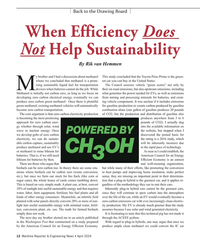 )
April 2024 - Maritime Reporter and Engineering News page: 12
)
April 2024 - Maritime Reporter and Engineering News page: 12frustrating to note that this technical pig has not made it The next day my brother alerted me to an article published through the ACEEE python. in the Washington Post that commented on a study prepared With regard to plug-in hybrids, one may argue that once we by the American Council for an Energy Ef? cient
-
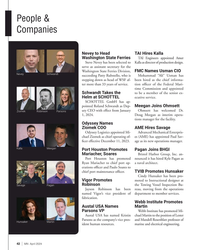 )
April 2024 - Marine News page: 42
)
April 2024 - Marine News page: 42People & Companies Nevey to Head TAI Hires Kalla Washington State Ferries TAI Engineers appointed Amer Steve Nevey has been selected to Kalla as director of production design. serve as assistant secretary for the FMC Names Usman CIO Washington State Ferries Division, Nevey Schwandt succeeding Patty
-
 )
February 2024 - Maritime Reporter and Engineering News page: 24
)
February 2024 - Maritime Reporter and Engineering News page: 24R&D marinized version of the V228 product from 8 to 16 cylinders. through improved lifecycle cost, trade-offs, it also allows us That engine is called the V228 for the bore size in millimeters. to do concurrent design and reliability demonstrations. We’re With the advent of emissions regulations for EPA
-
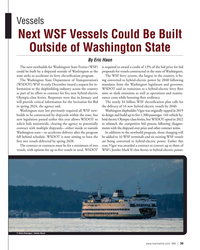 )
February 2024 - Marine News page: 39
)
February 2024 - Marine News page: 39Vessels Next WSF Vessels Could Be Built Outside of Washington State By Eric Haun The next newbuilds for Washington State Ferries (WSF) is required to award a credit of 13% of the bid price for bid could be built by a shipyard outside of Washington as the proposals for vessels constructed in the state of
-
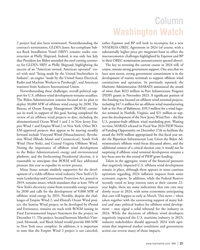 )
February 2024 - Marine News page: 21
)
February 2024 - Marine News page: 21Column Washington Watch 2 project had also been terminated. Notwithstanding the rather Equinor and BP will look to recompete for a new contract’s termination, GLDD’s Jones Act-compliant Sub- NYSERDA OREC Agreement in 2024 (of course, with a sea Rock Installation Vessel (SRIV) remains under con- substantial
-
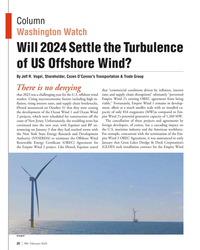 )
February 2024 - Marine News page: 20
)
February 2024 - Marine News page: 20Column Washington Watch Will 2024 Settle the Turbulence of US Offshore Wind? By Jeff R. Vogel, Shareholder, Cozen O’Connor’s Transportation & Trade Group There is no denying that “commercial conditions driven by in? ation, interest that 2023 was a challenging year for the U.S. offshore wind rates and
-
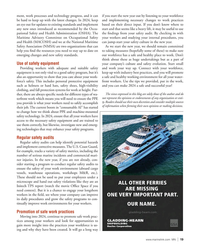 )
February 2024 - Marine News page: 19
)
February 2024 - Marine News page: 19ment, work processes and technology progress, and it can if you start the new year out by listening to your workforce be hard to keep up with the latest changes. In 2024, keep and implementing necessary changes to work practices an eye out for updates to existing standards and implement based on their
-
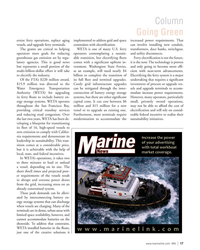 )
February 2024 - Marine News page: 17
)
February 2024 - Marine News page: 17. This is good news comes with a signi? cant upfront in- it is the now. The technology is proven but represents a small portion of the vestment. Washington State Ferries, and only going to become more ef? - multi-billion-dollar effort it will take as an example, will need nearly $4 cient with near-term
-
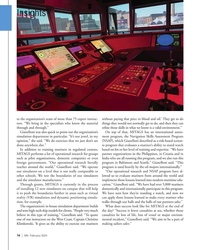 )
February 2024 - Marine News page: 14
)
February 2024 - Marine News page: 14Insights to the organization’s team of more than 75 expert instruc- without paying that price in blood and oil.’ They get to do tors. “We bring in the specialists who know the material things they would not normally get to do, and then they can through and through.” re? ne those skills in what we know
-
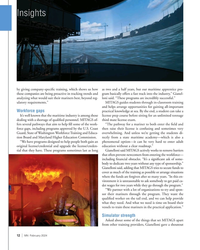 )
February 2024 - Marine News page: 12
)
February 2024 - Marine News page: 12the ? eld and force gaps, including programs approved by the U.S. Coast then raise their license is confusing and sometimes very Guard, State of Washington Workforce Training and Educa- overwhelming. And unless we’re getting the students di- tion Board and Maryland Higher Education Commission. rectly
-
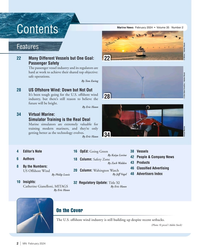 )
February 2024 - Marine News page: 2
)
February 2024 - Marine News page: 2Marine News February 2024 • Volume 35 Number 2 Contents Features 22 Many Different Vessels but One Goal: 22 Passenger Safety The passenger vessel industry and its regulators are hard at work to achieve their shared top objective: safe operations. By Tom Ewing 28 US Offshore Wind: Down but Not
-
 )
January 2024 - Marine Technology Reporter page: 56
)
January 2024 - Marine Technology Reporter page: 56FLOATING OFFSHORE WIND GAZELLE WIND POWER We’re already working on the pre-FEED, and now we’re go- clude 70 turbines of 15MW each, and has preselected Gazelle ing to be working on the engineering portion. Our main goal as one of the providers for the offshore wind platform. So, is to prove the concept
-
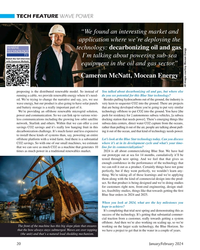 )
January 2024 - Marine Technology Reporter page: 20
)
January 2024 - Marine Technology Reporter page: 20TECH FEATURE WAVE POWER “We found an interesting market and application where we’re deploying the MARINE technology: decarbonizing oil and gas. TECHNOLOGY TV I’m talking about powering sub-sea Watch the full interview with Cameron McNatt: equipment in the oil and gas sector.” Cameron McNatt, Mocean
-
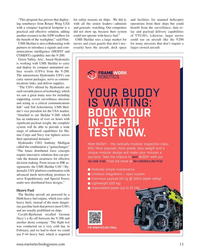 )
January 2024 - Marine Technology Reporter page: 13
)
January 2024 - Marine Technology Reporter page: 13“This program has proven that deploy- for safety reasons on ships. We did it, and facilities for manned helicopter ing sonobuoys from Rotary Wing UAS with all the senior leaders—admirals operations from their ships but could with a compact logistical footprint is a and generals--watching. Our competito
-
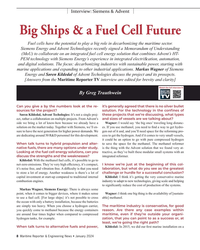 )
January 2024 - Maritime Reporter and Engineering News page: 8
)
January 2024 - Maritime Reporter and Engineering News page: 8Siemens Energy Big Ships & a Fuel Cell Future Fuel cells have the potential to play a big role in decarbonizing the maritime sector. Siemens Energy and Advent Technologies recently signed a Memorandum of Understanding (MoU) to collaborate on an integrated fuel cell energy solution that combines Advent’s
-
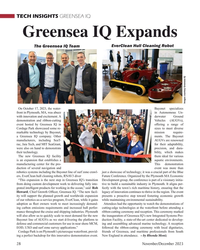 )
November 2023 - Marine Technology Reporter page: 28
)
November 2023 - Marine Technology Reporter page: 28TECH INSIGHTS GREENSEA IQ Greensea IQ Expands The Greensea IQ Team EverClean Hull Cleaning Robot Images courtesy Greensea IQ On October 17, 2023, the water- Bayonet specializes front in Plymouth, MA, was abuzz in Autonomous Un- with innovation and excitement. A derwater Ground demonstration and ribbon-cut
-
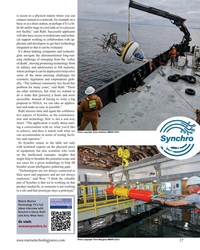 )
November 2023 - Marine Technology Reporter page: 27
)
November 2023 - Marine Technology Reporter page: 27is access to a physical station where you can connect sensors to a network, for example on a buoy or at a shore station, or perhaps if it’s a lit- tle bit earlier stage in a test tank or in a pressure test facility,” said Ruhl. Successful applicants will also have access to technicians and techni- cal
-
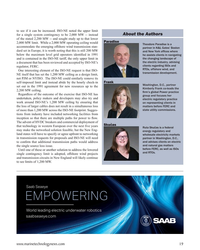 )
November 2023 - Marine Technology Reporter page: 19
)
November 2023 - Marine Technology Reporter page: 19ceiling as a design limit, not PJM or NYISO. The ISO-NE could similarly remove its Frank self-imposed limit and instead abide by the hourly check-in Washington, D.C., partner set out in the 1991 agreement for new resources up to the Kimberly Frank co-leads the 2,200 MW ceiling. ? rm’s global Power practice
-
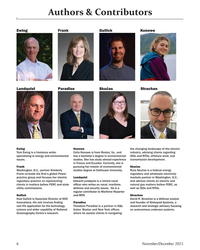 )
November 2023 - Marine Technology Reporter page: 6
)
November 2023 - Marine Technology Reporter page: 6has study abroad experience transmission development. in France and Ecuador. Currently, she is Frank pursuing her master of environmental Skucas Washington, D.C., partner Kimberly studies degree at Dalhousie University. Ruta Skucas is a federal energy Frank co-leads the ? rm’s global Power regulatory
-
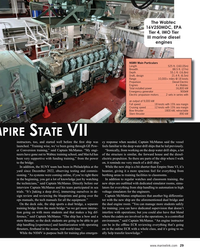 )
December 2023 - Maritime Reporter and Engineering News page: 29
)
December 2023 - Maritime Reporter and Engineering News page: 29The Wabtec 16V250MDC, EPA Tier 4, IMO Tier III marine diesel engines NSMV Main Particulars Length 525 ft. (160.05m) Breadth 88.5 ft. (27m) Depth 55.1 ft. (16.8m) Draft, design 21.4 ft. (6.5m) Range 10,000+ miles @ 18 knots Propulsion Diesel Electric Engines 4 x Wabtec Total installed power 16
-
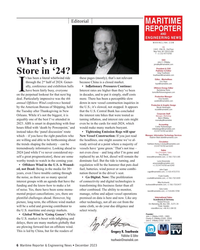 )
December 2023 - Maritime Reporter and Engineering News page: 6
)
December 2023 - Maritime Reporter and Engineering News page: 6Editorial MARITIME REPORTER AND ENGINEERING NEWS M A R I N E L I N K . C O M HQ 118 E. 25th St., 2nd Floor New York, NY 10010 USA T +1 212 477 6700 CEO John C. O’Malley What’s in [email protected] President & COO Publisher & Editor Greg Trauthwein Store in ‘24? [email protected] t has
-
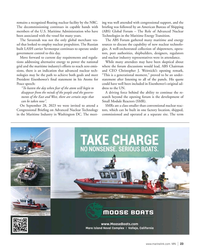 )
November 2023 - Marine News page: 23
)
November 2023 - Marine News page: 23reac- Congressional Brie? ng on Advanced Nuclear Technology tors, which can be built in one factory location, shipped, in the Maritime Industry in Washington DC. The meet- commissioned and operated at a separate site. The term www.marinelink.com MN 23
